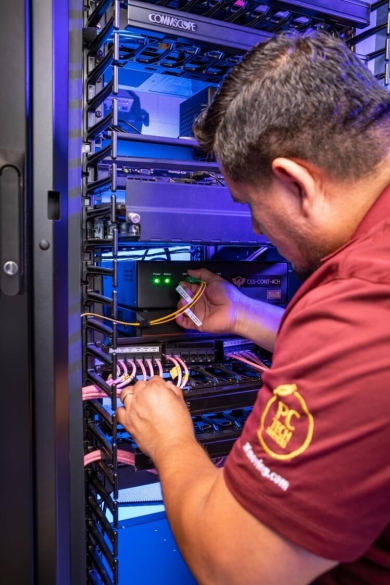By Tucker Gladhill, Vice President – Technology Services, Commercial Services Division
Migrating your on-premise server room may seem like a daunting task, yet with careful planning and execution, you can navigate this complex process smoothly.
The key to a successful migration lies in thoughtful consideration of the necessary steps and thorough preparation. I will guide you through the essential aspects of planning, assessing risk, and executing the migration process. By following these steps, you can minimize disruptions to your business operations and safeguard against data loss or downtime.
Planning your server room migration
One of the first steps in planning your migration is to determine what you need to move and what can be left behind. Proper planning is essential to ensure a smooth and successful server room migration.
Create an inventory of all equipment and determine which are critical to your business operations. A deep dive into your service-level agreements (SLAs), reviewing original equipment manufacturer (OEM) warranties, and understanding the lifecycle stage of your appliances is also an important step.
This data will come in handy when planning for future scale. Also consider the location of your new server room, how it will be powered and cooled, and the network infrastructure required to support your equipment.
Assessing the risk and impact
Assessing the risks and impact of your migration is a critical step that should not be overlooked. Identify the risks associated with the migration, such as hardware failure, data loss, or network connectivity issues. You should also determine the impact that a migration will have on your business operations, like downtime and loss of productivity. It is important to work with your team to identify potential risks and plan for contingencies to minimize the impact of any issues that may arise.
Preparing for migration day
Preparing for migration day is crucial to ensure a smooth transition. Before migration day, make certain that all necessary equipment, cabling, and network infrastructure is in place. Check that all necessary software and hardware are available, and that all data is backed up. Create a detailed migration plan that outlines the steps to be taken during the migration process. Test the plan before the migration day to ensure it works as intended.
Sample migration plan
 The following is the foundation to build your migration on. Every migration will yield a deeper understanding of what your organization needs and therefore a more detailed outline:
The following is the foundation to build your migration on. Every migration will yield a deeper understanding of what your organization needs and therefore a more detailed outline:
- Inventory of equipment: Create an inventory of all equipment to be migrated, including servers, storage devices, switches, and routers.
- Power and cooling: Ensure that the new location has adequate power and cooling capacity to support the equipment.
- Network infrastructure: Assess the network infrastructure required to support the equipment and verify that it is in place.
- Data backups: Check that all data is backed up and that backup systems are in place.
- Labeling and organizing equipment: Label all equipment so that it can be easily identified and organized during the migration process.
- Disconnect and power down equipment: Disconnect and power down all equipment to be migrated.
- Physical move of equipment: Move all equipment to the new location and re-connect all cabling.
- Power on equipment: Power on all equipment and verify that it is functioning correctly.
- Testing and validation: Test and validate all equipment and software systems to ensure that they are functioning correctly.
- Validation of migration: Conduct a thorough validation of the migration process to see that all systems are operating correctly and that data has been migrated successfully.
- Post-migration support: Provide post-migration support to end-users to make certain that they can access all necessary systems and that there are no issues with the new location.
Migrating your server room
When migrating your server room, it is essential to have a team of experienced professionals who understand the migration process. Your team should be familiar with your equipment, network infrastructure, and software systems. During the migration process, check that all equipment is properly labeled and organized, and that all cabling is connected correctly. Test all equipment and software systems to verify that they are working correctly before completing the migration process. After the migration is complete, conduct a thorough testing and validation process to see that all systems are operating correctly.
Migrating your on-prem server room requires a well-coordinated effort and the expertise of a knowledgeable team. By thoroughly planning and assessing the risks involved, you can mitigate potential issues and ensure a smoother transition.
Remember to prepare meticulously for migration day, test your migration plan, and validate the process to guarantee optimal functionality. By investing time and effort into this process, you can pave the way for a successful migration and set the stage for future scalability and growth.


